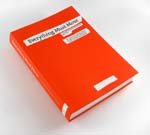
|

|
|
Home Site Search Contact Us Subscribe
|
|
|
Book Review: "Everything Must Move: 15 Years at Rice School of Architecture 1994-2009" There’s a Texas flood of architectural ideas that gives ample evidence of an architecture school that unsettles pat assumptions. Who could ask for anything more? By Norman Weinstein July 21, 2009 There’s a little-recognized category of architectural literature that could be labeled “architectural school showcasing.” John Hejduk’s Cooper Union compendium of community creativity, the various annuals from London’s Architectural Association, and a recent Actar book skating across the surfaces of a year’s worth of instruction at Harvard’s Graduate School of Design represent salient examples. But this new architectural showcase – or real course catalog in the deeps – from Rice School of Architecture trumps these earlier titles in this genre for some fascinating reasons.
Unlike Cooper Union, AA, and GSD, the Rice School of Architecture (RSA) finds itself nested in a city with relatively few architectural masterworks. Even more to the point, it is an architecture school with windows facing an unzoned metropolitan sprawl made possible by the wholesale rapaciousness (and charitable impulses) of Big Oil. Students and faculty ensconced in such a landscape, lacking the civilized felicities budding architects consume daily in Cambridge, MA, or London, turn extreme, intellectually and passionately, in their speculative designs and loose philosophical ramblings. They seem like loose balls in rattling, old-school pin-ball machines, clanking between visions of utopia and dystopia with crazy, zigzag velocity.
Everything Must Move, edited by Luke Bulman and Jessica Young (Rice University School of Architecture, 2009), is a title saturated with irony, since Houston is the Divine Comedy of car culture in shades of gridlock. We’re offered a kind of scattershot messy sprawl of potent and downright silly urbanisms. There’s a sometimes sentimental homage to Houston’s shotgun houses, like so many white kids trying to assume the blues diction of Muddy Waters, but then there’s the sheer intellectual and moral courage of graduate student Brett Zamore who, under the direction of his advisor and RSA Dean Lars Lerup, bought a derelict shotgun house in Houston, restored it, and created a distinctive dwelling for local artists. An elucidation by Rice professor Gordon Wittenberg clarifies why this project wasn’t simply a recasting of the worthy “help the poor” design programs at Auburn and Yale:
Constructing a real building for a thesis project, turning a thesis project into a real estate project, and reusing a building in a city that has consistently erased everything over a generation old – any of these would have made an improbable thesis project. Doing all of them together distinguished....Zamore (who) was able to launch a successful career designing and building kit and conventional small houses that drew on the architectural heritage of the rural South.
In the freewheeling “ideas on the move” climate of RSA, it seems impossible to overstate the importance of the inspired leadership of Dean Lerup. His various contributions to the book always give the most vertiginous and vague of student theorizing a pragmatic twist. He’s also a cheerleader for the type of integrated teamwork among students and faculty that needs cheerleading in a field riddled with stadium-sized egos. And with pages of student projects more impatiently self-assured than questioning (will Houston’s car culture really be redeemed by new parking garage designs?), Lerup states with seasoned wisdom:
Architects are hopelessly mired in the perfect object; I guess that prohibits me from claiming the title. Ambiguity is my muse – my escape route – my hope for redemption.
There’s a Texas flood of architectural ideas that gives ample evidence of an architectural school that unsettles pat assumptions. Who could ask for anything more?
Norman Weinstein writes about architecture and design for Architectural Record and The Christian Science Monitor. He consults with architects and engineers interested in communicating more profitably. You can reach him at nweinste@mindspring.com.
See also:
Op-Ed:
Life After Ada: Reassessing the Utility of Architectural Criticism
An exclusive series by Norman Weinstein focusing on the overlooked foundations of architecture: oral and written communication.
Book Review: A
Subversive Book Every Architect Needs: "Architect's Essentials of
Negotiation" by Ava J. Abramowitz
Book Review: A Perspective from One Elevation: "Conversations With Frank Gehry" by Barbara Isenberg Gehry's conversations offer portraits of an astute listener as well as talker, an architect as aware of his flaws and limitations as of his virtues.
Best Architecture Books of 2008
Book Review: You've Got to Draw the Line Somewhere A review of Drafting Culture: a Social History of Architectural Graphic Standards by George Barnett Johnston
Book Review: "NeoHooDoo: Art for a Forgotten Faith," edited by Franklin Sirmans Sharpen your pencils - and get ready to do a NeoHooDoo shimmy |
(click on pictures to enlarge) 
|
© 2009 ArchNewsNow.com